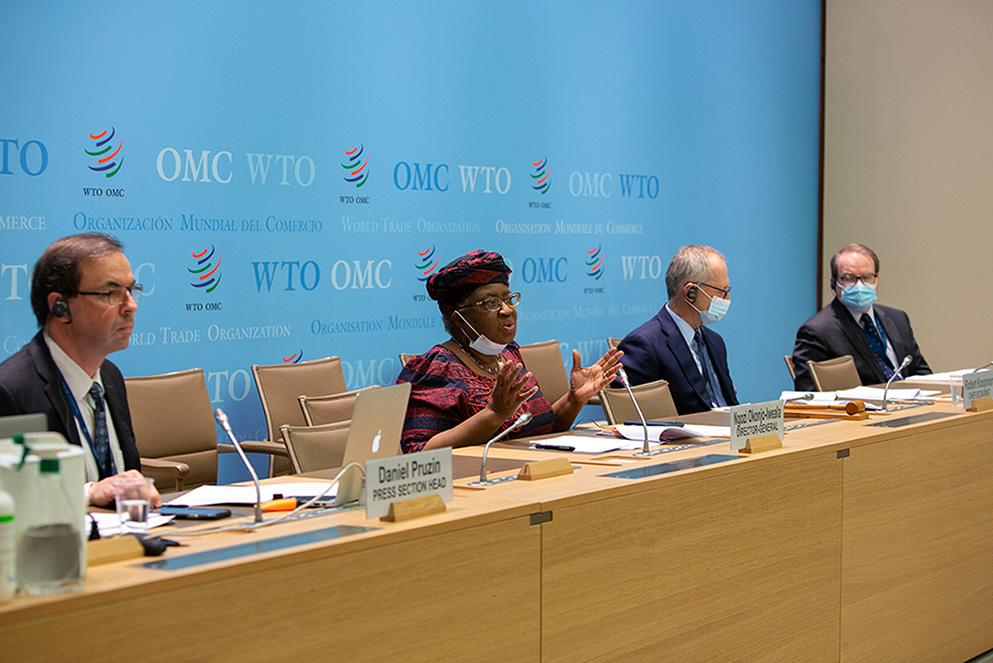More
MAIN POINTS
- World merchandise trade volume is expected to increase by 8.0% in 2021 after falling 5.3% in 2020, a smaller decline than previously estimated.
- Trade growth will likely slow to 4.0% in 2022, with the total volume of global trade remaining below the pre-pandemic trend.
- World GDP at market exchange rates should increase by 5.1% in 2021 and 3.8% in 2022, after contracting by 3.8% in 2020.
- Merchandise trade in nominal dollar terms fell in 2020 by 8% while commercial services exports declined by 20%.
- Falling oil prices led to a 35% contraction in trade in fuels in 2020.
- Travel services were down 63% in 2020 and are not expected to fully recover until the pandemic wanes.
Trade growth should then slow to 4.0% in 2022, and the effects of the pandemic will continue to be felt as this pace of expansion would still leave trade below its pre-pandemic trend (Chart 1).
The relatively positive short-term outlook for global trade is marred by regional disparities, continued weakness in services trade, and lagging vaccination timetables, particularly in poor countries. COVID-19 continues to pose the greatest threat to the outlook for trade, as new waves of infection could easily undermine any hoped-for recovery.
“The strong rebound in global trade since the middle of last year has helped soften the blow of the pandemic for people, businesses, and economies,” WTO Director-General Ngozi Okonjo‑Iweala said. “Keeping international markets open will be essential for economies to recover from this crisis and a rapid, global and equitable vaccine roll-out is a prerequisite for the strong and sustained recovery we all need.”
“Ramping up production of vaccines will allow businesses and schools to reopen more quickly and help economies get back on their feet. But as long as large numbers of people and countries are excluded from sufficient vaccine access, it will stifle growth, and risk reversing the health and economic recovery worldwide,” she said.
The Director-General added that trade through value chains has helped countries access food and essential medical supplies during the crisis.
“Manufacturing vaccines requires inputs from many different countries. One leading COVID-19 vaccine includes 280 components sourced from 19 different countries,” she said. “Trade restrictions make it harder to ramp up production. The WTO has helped keep trade flowing during the crisis. Now, the international community must leverage the power of trade to expand access to life-saving vaccines.”
Chart 1: World merchandise trade volume, 2015Q1-2022Q4
Index, 2015=100
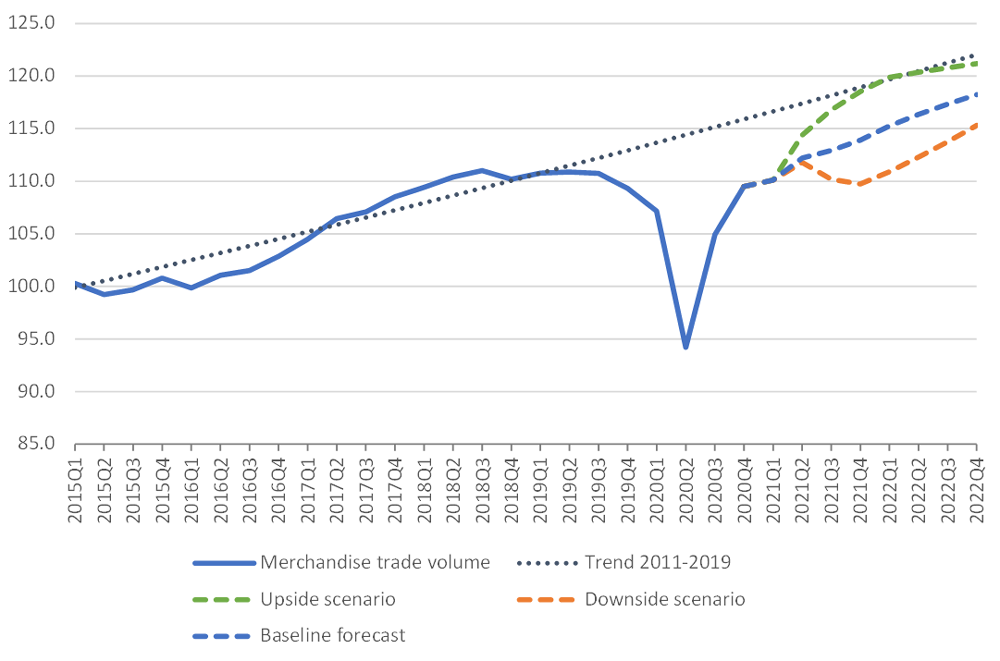
Sources: WTO and UNCTAD for trade volume data; WTO for forecasts.
Short-term risks to the forecast are firmly on the downside and centred on pandemic-related factors. These include insufficient production and distribution of vaccines, or the emergence of new, vaccine-resistant strains of COVID-19. Over the medium-to-long term, public debt and deficits could also weigh on economic growth and trade, particularly in highly indebted developing countries.
The forecast illustration in Chart 1 shows two alternative scenarios for trade. In the upside scenario, vaccine production and dissemination would accelerate, allowing containment measures to be relaxed sooner. This would be expected to add about 1 percentage point to world GDP growth and about 2.5 percentage points to world merchandise trade volume growth in 2021. Trade would return to its pre-pandemic trend by the fourth quarter of 2021. In the downside scenario, vaccine production does not keep up with demand and/or new variants of the virus emerge against which vaccines are less effective. Such an outcome could shave 1 percentage point off of global GDP growth in 2021 and lower trade growth by nearly 2 percentage points.
For the whole of 2020, merchandise trade was down 5.3% (Table 1). This drop is smaller than the 9.2% decline foreseen in the WTO's previous forecast in October 2020. The better than expected performance towards the end of the year can partly be explained by the announcement of new COVID-19 vaccines in November, which contributed to improved business and consumer confidence. Box 1 below discusses reasons for the forecast upgrade in more depth.
The volume of world merchandise trade plunged 15.0% year-on-year in the second quarter of 2020 (revised up from -17.3 % in October) as countries around the world imposed lockdowns and travel restrictions to limit the spread of COVID-19. Lockdowns were eased in the second half of the year as infection rates came down, allowing goods shipments to surge back to near 2019 levels by the fourth quarter.
Faster trade and output growth in the second half of 2020 was supported by major government policy interventions, including significant fiscal stimulus measures in the United States. These measures boosted household incomes and supported continued spending on all goods, including imports. In addition, many businesses and households adapted to the changing circumstances, finding innovative ways to sustain economic activity in the face of health-related restrictions on mobility. Effective management of the pandemic limited the extent of the economic downturn in China and other Asian economies, allowing them to continue importing. These actions helped prop up global demand and may have prevented an even larger trade decline.
Trade in nominal US dollar terms fell even more sharply than trade in volume terms in 2020. World merchandise export values were down 8% compared to the previous year, while commercial services receipts tumbled 20%. Services trade was especially weighed down by international travel restrictions, which prevented the delivery of services requiring physical presence or face-to-face interaction.
The impact of the pandemic on merchandise trade volumes differed across regions in 2020, with most regions recording large declines in both exports and imports (Table 1). Asia was the sole exception, with export volumes up 0.3% and import volumes down a modest 1.3%. Regions rich in natural resources saw the largest declines in imports, including Africa (-8.8%), South America (‑9.3%) and the Middle East (-11.3%), probably due to reduced export revenues as oil prices fell around 35%. In comparison to other regions, the decline in North American imports was relatively small (-6.1%).
In 2021, demand for traded goods will be driven by North America (11.4%) thanks to large fiscal injections in the United States, which should also stimulate other economies through the trade channel. Europe and South America will both see import growth of around 8%, while other regions will register smaller increases.
Much of global import demand will be met by Asia, exports from which are expected to grow by 8.4% in 2021. European exports will increase nearly as much (8.3%), while shipments from North America will see a smaller rise (7.7%). Strong forecasts for export growth in Africa (8.1%) and the Middle East (12.4%) depend on travel expenditures picking up over the course of the year, which would strengthen demand for oil. Meanwhile, South America will see weaker export growth (3.2%), as will the Commonwealth of Independent States (CIS), including certain former and associate Members (4.4%).
BOX 1: WHY TRADE AND OUTPUT DECLINED LESS THAN FEARED AT THE START OF THE PANDEMIC
In April 2020, when over half the global population was under lockdown orders, the sheer extent of pandemic-related uncertainty led the WTO's trade forecast to explore two distinct scenarios for how COVID-19 would impact global trade: (1) a relatively optimistic scenario, with a sharp drop followed by a recovery starting in the second half of 2020, and (2) a more pessimistic scenario with a steeper initial decline and slower recovery. It quickly became apparent that the optimistic scenario was the one actually unfolding, which the WTO announced in June 2020. Yet even this scenario overstated the extent of the decline: the initial April estimate of -12.9% was revised upwards to -9.2% by October. The final decline was -5.3%. Similarly, the IMF's projected decline for world GDP at market exchange rates in 2020 went from -6.1% last June to -4.7% in October, and finally to -3.8% in January 2021.
What accounts for the smaller-than-expected contractions in growth and trade?
Strong monetary and fiscal policies by many governments were probably the biggest factors. Much greater in scale and geographic coverage than the response to the 2008-09 global financial crisis, these policies helped prevent a larger drop in global demand, which would have reduced trade further. Fiscal policy in particular boosted personal incomes in advanced economies, allowing some households to maintain relatively high levels of consumption, and supporting more exports than would otherwise have been the case.
Lockdowns and travel restrictions caused consumers to shift spending away from non-traded services and towards goods. Innovation and adaptation by businesses and households kept economic activity from falling even more. Manufacturing supply chains were able to resume operations, and many people shifted to working remotely, generating income and demand. Finally, trade policy restraint by WTO members prevented protectionism from strangling world trade. As WTO monitoring has documented, many restrictive trade measures imposed at the start of the pandemic were rolled back, and new liberalising measures were introduced. Despite continuing challenges, notably around vaccine trade, the multilateral trading system kept trade flowing and prevented worse outcomes, as members were restrained by commitments and economic self-interest. As during the global financial crisis, the foundation of the system proved sound.
Table 1: Merchandise trade volume and real GDP, 2017-2022a
Annual % change
2017 |
2018 |
2019 |
2020 |
2021P |
2022P |
|
Volume of world merchandise tradeb |
4.9 |
3.2 |
0.2 |
-5.3 |
8.0 |
4.0 |
Exports |
||||||
North America |
3.4 |
3.8 |
0.3 |
-8.5 |
7.7 |
5.1 |
South Americac |
2.3 |
0.0 |
-2.2 |
-4.5 |
3.2 |
2.7 |
Europe |
4.1 |
1.9 |
0.6 |
-8.0 |
8.3 |
3.9 |
CISd |
3.9 |
4.1 |
-0.3 |
-3.9 |
4.4 |
1.9 |
Africa |
4.7 |
2.7 |
-0.5 |
-8.1 |
8.1 |
3.0 |
Middle East |
-2.1 |
4.7 |
-2.5 |
-8.2 |
12.4 |
5.0 |
Asia |
6.7 |
3.8 |
0.8 |
0.3 |
8.4 |
3.5 |
Imports |
||||||
North America |
4.4 |
5.1 |
-0.6 |
-6.1 |
11.4 |
4.9 |
South Americac |
4.5 |
5.4 |
-2.6 |
-9.3 |
8.1 |
3.7 |
Europe |
3.9 |
1.9 |
0.3 |
-7.6 |
8.4 |
3.7 |
CISd |
14.0 |
4.1 |
8.5 |
-4.7 |
5.7 |
2.7 |
Africa |
-1.7 |
5.4 |
2.6 |
-8.8 |
5.5 |
4.0 |
Middle East |
1.1 |
-4.1 |
0.8 |
-11.3 |
7.2 |
4.5 |
Asia |
8.4 |
5.0 |
-0.5 |
-1.3 |
5.7 |
4.4 |
World GDP at market exchange rates |
3.3 |
3.0 |
2.4 |
-3.8 |
5.1 |
3.8 |
North America |
2.3 |
2.8 |
1.9 |
-4.1 |
5.9 |
3.8 |
South Americac |
0.8 |
0.2 |
-0.7 |
-7.8 |
3.8 |
3.0 |
Europe |
2.8 |
2.0 |
1.5 |
-7.1 |
3.7 |
3.6 |
CISd |
2.3 |
2.9 |
2.1 |
-0.5 |
1.0 |
1.2 |
Africa |
3.1 |
3.1 |
2.9 |
-2.9 |
2.6 |
3.8 |
Middle East |
0.7 |
0.5 |
0.1 |
-6.0 |
2.4 |
3.5 |
Asia |
5.1 |
4.6 |
4.1 |
-1.1 |
6.1 |
4.1 |
a Figures for 2021 and 2022 are projections.
b Average of exports and imports.
c Refers to South and Central America and the Caribbean.
d Refers to Commonwealth of Independent States (CIS), including certain associate and former member States.
Source: WTO for trade, consensus estimates for GDP.
Details on trade statistics
The charts in this section illustrate annual and quarterly WTO trade statistics in greater detail and highlight certain noteworthy trade-related indicators.
Chart 2 below shows quarterly merchandise export and import volume indices by region for 2015 to 2020, plus projections for 2021 and 2022. In the second quarter of 2020, North America and Europe saw sharp year-on-year declines in export volumes, down 25.8% and 20.4% respectively. By the fourth quarter these regions had recovered much of their lost ground, with respective year-on-year declines of just 3.0% and 2.4%. Middle Eastern exports also fell precipitously in the second quarter as oil consumption slumped worldwide due to restrictions on international and domestic travel.
Asian exports saw a much smaller decline of 7.2% in the second quarter, but by the fourth quarter they were up 7.7% compared to the previous year. Their rapid recovery can be explained by the relatively small impact that COVID-19 had on certain Asian economies, and by the fact that the region has been supplying the world with consumer goods and medical supplies during the pandemic, driving up regional export totals.
In the forecast periods we see a divergence between regions with faster and slower trade growth. On the import side, Africa, South America and the Middle East will continue to see their merchandise trade stagnate while other regions will pull ahead. On the export side, most regions will only see modest gains while Asia continues to supply large quantities of goods to global markets.
Chart 2: Merchandise exports and imports by region, 2015Q1-2022Q4
Volume index, 2015=100
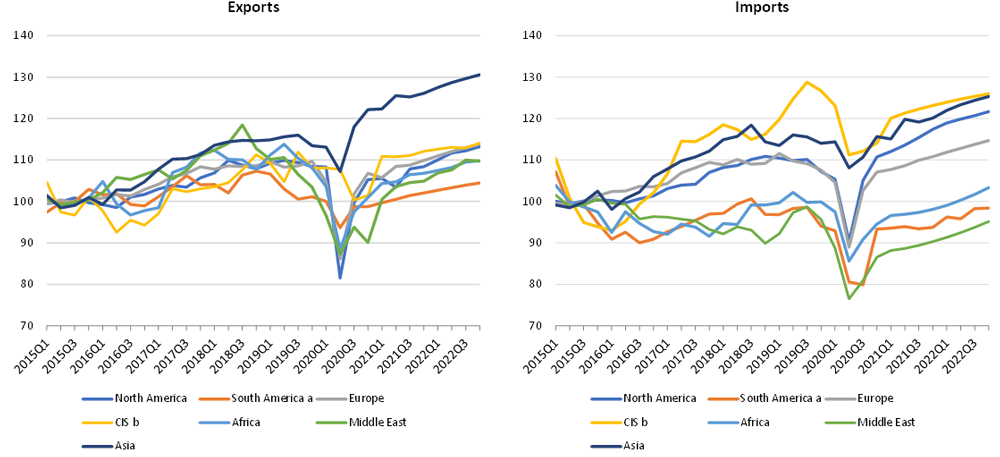
a Refers to South and Central America and the Caribbean.
b Refers to Commonwealth of Independent States, including certain associate and former member States.
Source: WTO and UNCTAD.
Chart 3 illustrates the quarterly evolution of merchandise trade in current US dollar terms over the course of 2020. It indicates that the value of world trade in manufactured goods was 6% higher in the fourth quarter of 2020 than in the same period of the previous year. This resurgence may be attributable to the resumption of factory operations in alignment with safety measures required to protect workers from COVID-19. Trade in agricultural products was up by a similar amount over the same period. In contrast, the value of Fuels and mining products trade was still down 19% in the fourth quarter. The value of merchandise trade overall was up slightly compared to the previous year (2%), but this increase might be exaggerated due to the fact that world trade was already slowing in the fourth quarter of 2019, before the pandemic.
Chart 3: Year-on-year growth in world merchandise trade, 2020Q1-2020Q4
% change in US$ values
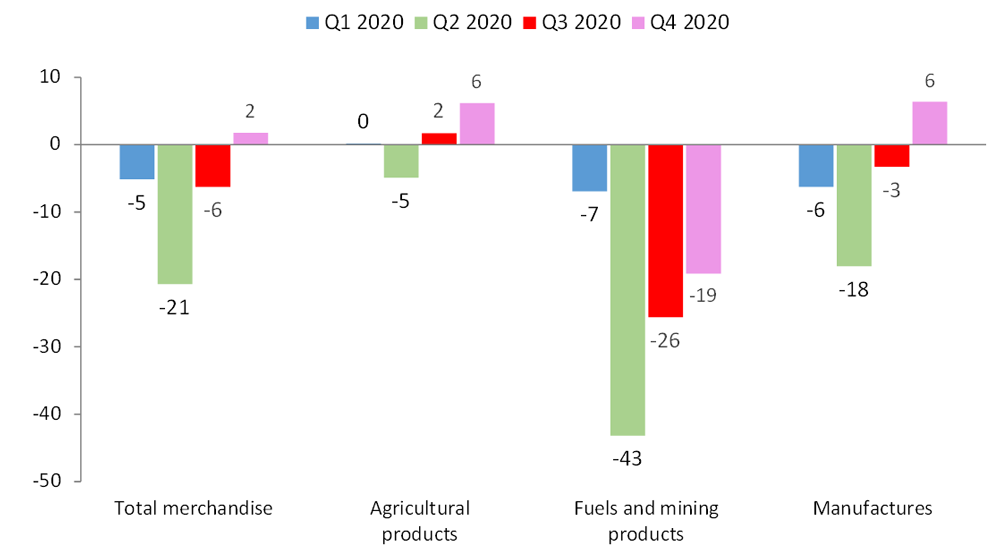
Source: WTO estimates.
Most categories of manufactured goods saw significant gains in the second half of 2020. This is illustrated by Chart 4, which shows monthly and quarterly year-on-year growth in the US dollar value of world trade by sector. World trade in Iron and steel was down 17% in the third quarter, but this decline was reduced to 2% by the fourth quarter. Iron and steel trade is indicative of broader economic conditions as these products are heavily used in both automobile manufacturing and building construction, both of which were hit hard by the pandemic.
Strong growth in textiles trade in both the third and fourth quarter probably reflects high demand for medical face coverings, which is included in this category. Electronic goods including computers also saw steady growth of 12% in the second half of 2020, reflecting strong demand as households and businesses upgraded equipment to facilitate working remotely.
Chart 5 shows year-on-year changes in world commercial services trade by major category. For the whole of 2020, Travel and Transport services were down 63% and 19%, respectively. Meanwhile, the category Other commercial services (including financial services and computer services) held up well, falling only 2%. Finally, Goods-related services fell 13%. Transport and Travel services were directly impacted by containment measures designed to limit the spread of COVID-19, many of which remain in place or have been tightened in response to the resurgence of the disease.
Detailed quarterly and annual statistics on merchandise and commercial services trade can be downloaded from the WTO’s online data portal at data.wto.org. A statistical supplement showing country ranks and shares in world trade can be downloaded here.
Chart 4: Year-on-year growth in world manufactured goods trade, 2020Q3-2020Q4
% change in US$ values
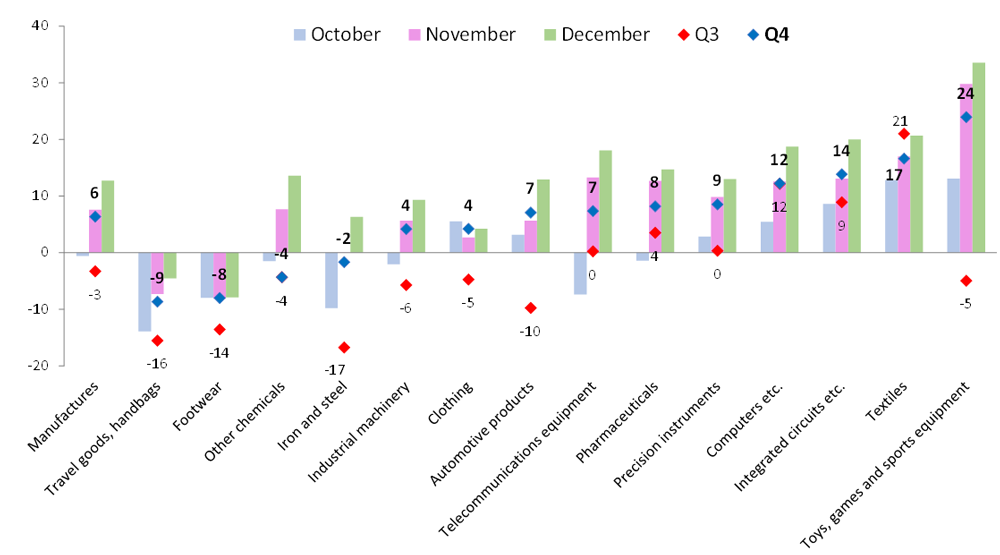
Source: WTO estimates.
Chart 5: Year-on-year growth in world commercial services trade, 2020Q1-2020Q4
% change in US$ values
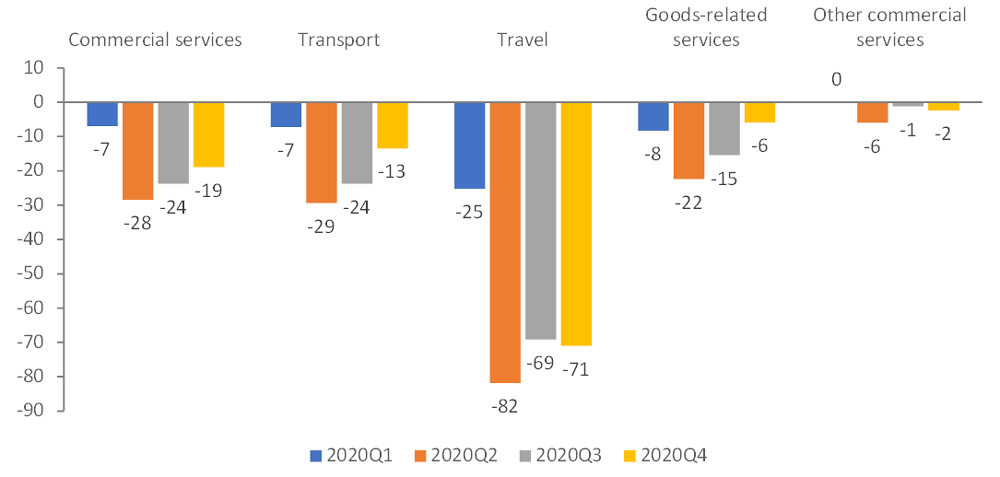
Source: WTO-UNCTAD-ITC estimates.
High frequency trade indicators
The WTO has been tracking timely, high-frequency trade-related indicators during the pandemic to better understand current trends in merchandise and commercial services trade. A selection of these are presented below to provide additional context to the forecast and trade statistics. The WTO has also sought to improve country-specific, time-series modelling projections of trade by including available, higher frequency indicators, such as container port throughput, production indicators and measures of financial risk, alongside lower frequency trade and GDP data, using mixed-data sampling techniques (MIDAS) (see Box 2).
Chart 6 shows daily counts of international flights and port calls of container ships, as well as prices of copper futures through 1 March 2021, depending on data availability.
The number of daily international flights fell around 80% in the first quarter of 2020 as countries closed their borders to reduce the spread of COVID-19. This number gradually picked up as cases declined and people resumed limited travel. The end of 2020 saw an uptick in flights as people travelled to meet friends and family for seasonal holidays, but a resurgence of the virus has reduced flights again in 2021. International flights are closely related to travel services, but also to transport services and goods trade, as passenger aircraft frequently carry air freight shipments.
In contrast to international flights, seaborne transport has been steadier during the pandemic. The number of port calls dipped in February and April of last year as well as in January of this year, reflecting peak periods of infection. The recent dip is worrying since countries have become increasingly reliant on international trade to obtain vital necessities such as food and medicine.
Daily prices of copper futures contracts declined sharply in March 2020 as news of the pandemic spread, but have risen since then, reflecting improving economic prospects. Copper feeds into the manufacture of electronics, demand for which has been strong as people and businesses have invested in technology to allow remote work. An uptick in November of last year probably reflected expectations of stronger economic growth after the announcement of new vaccines against COVID-19. The recent rise in 2021 may reflect expectations that stimulus measures in the US and elsewhere will boost economic growth.
Chart 6: International commercial flights, port calls and copper futures, 1 January 2020 - 1 March 2021
Indices, US$ per pound
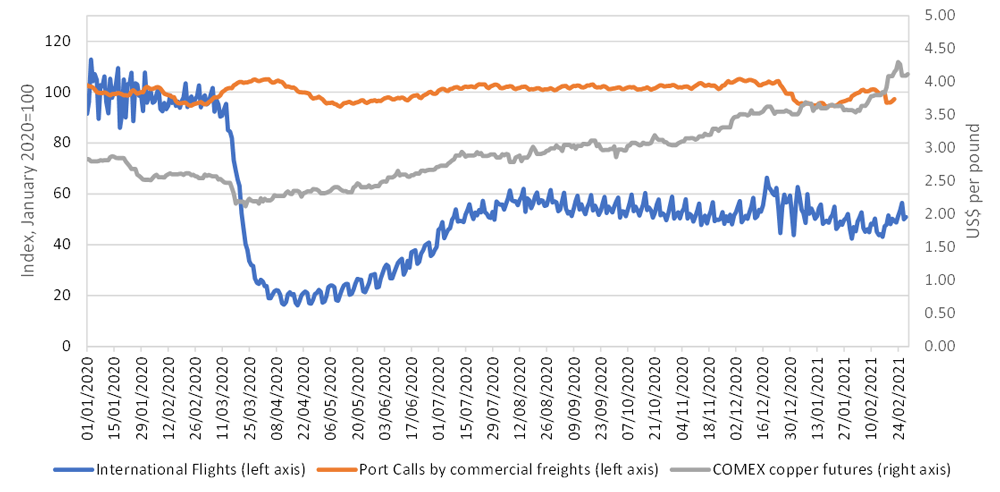
Source: International commercial flights - OpenSky Network; Port calls - Cerdeiro, Komaromi, Liu and Saeed (2020). Available at UN Comtrade Monitor; COMEX copper futures - Chicago Mercantile Exchange (CME).
Finally, Chart 7 shows the daily volume and average tone of news reports containing phrases related to “economic activity”, as monitored by the GDELT Project Summary Service. At the height of the pandemic, press reporting increased and the average tone of articles was mostly negative. As the pandemic progressed over the recent months, the number of articles declined but remained above pre-pandemic levels. The tone of reporting became more positive with the announcement of vaccines against the virus in November. A recent flattening in tone and the bottoming out of intensity could be related to the resurgence of the pandemic.
Chart 7 Illustration of phrases related to economic activity, 01 January 2020 – 15 March 2021
(% and index)
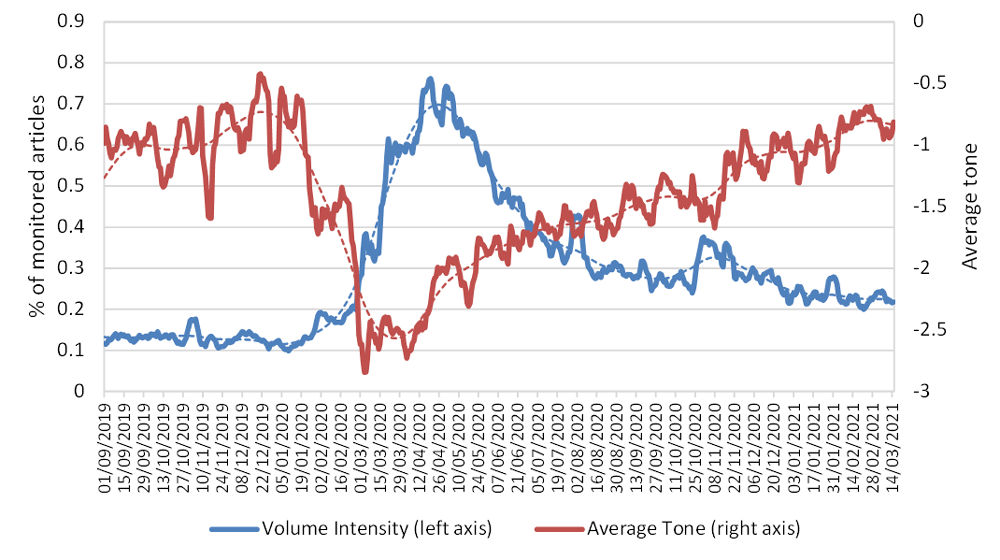
Source: The GDELT Project Summary Service.
BOX 2: FORECASTING TRADE IN SELECTED ECONOMIES USING MIXED-DATA SAMPLING
In the current forecast, the WTO used a relatively novel technique called mixed-data sampling (MIDAS) to refine import forecasts for Brazil, China, and the United States. MIDAS allows the use of higher frequency data (e.g. monthly or daily) alongside lower frequency data (e.g. quarterly or annual) without the need to average the high frequency values. This avoids loss of information in conventional forecast models, which are limited to using variables of the same frequency. For instance, conventional models might use monthly export orders averaged over each quarter to forecast quarterly merchandise trade. The MIDAS technique makes this averaging unnecessary, allowing analysts to exploit all available information on the dynamics of the higher frequency data. Brazil's MIDAS estimations used Markets Bond Index Plus (EMBI+) (reported daily) as a high frequency variable. This allowed the inclusion of information through the first week of March of the current year. EMBI+ was chosen because there is evidence that credit and financial conditions are a leading indicator for trade. Monthly data on inward loaded container throughput for the port of Hong Kong was used as a high-frequency indicator for China, while monthly loaded inbound throughput for the ports of Long Beach and Los Angeles were used for the United States. These estimations improved the short-term dynamics of forecasts and had a small but appreciable impact at regional and global levels. In all three cases, GDP and merchandise import volumes were used as low frequency variables. MIDAS is a useful complement to traditional forecasting techniques. The wider use of this and other novel techniques should help continue to refine WTO trade forecasts.
Share
Download this press release (pdf format, 10 pages, 615KB).
Problems viewing this page? If so, please contact [email protected] giving details of the operating system and web browser you are using.
